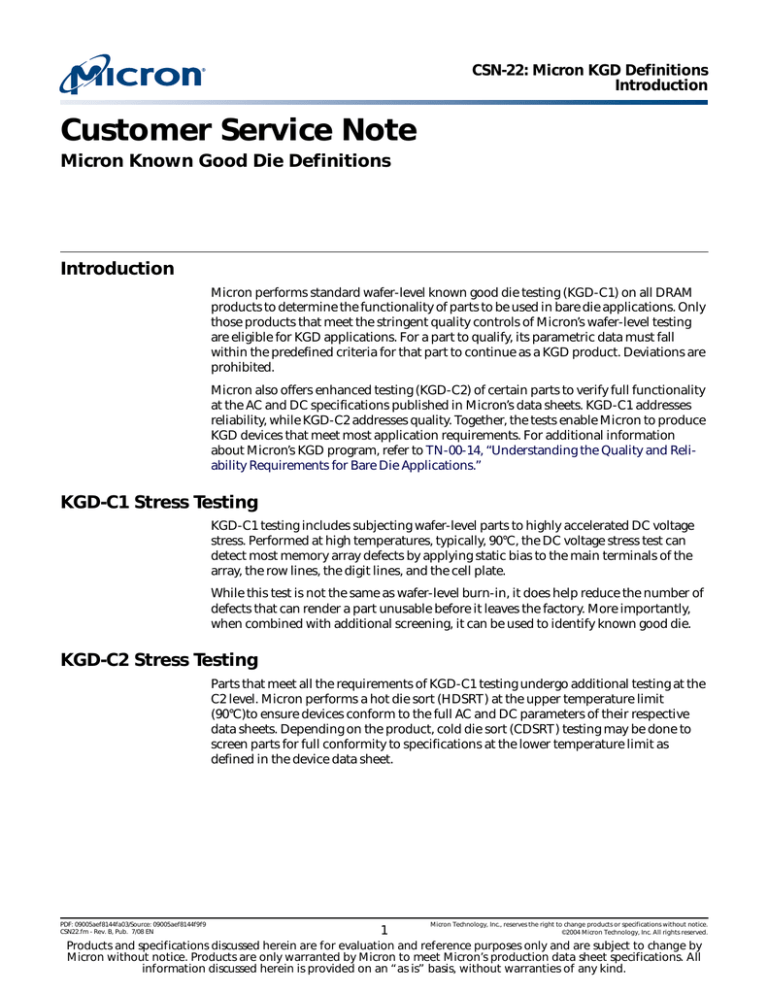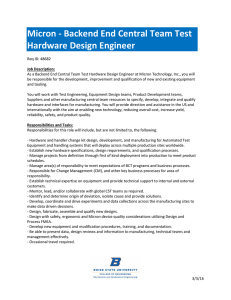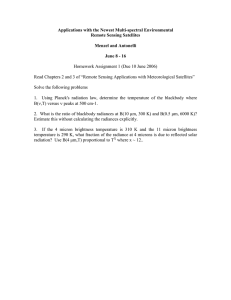
CSN-22: Micron KGD Definitions
Introduction
Customer Service Note
Micron Known Good Die Definitions
Introduction
Micron performs standard wafer-level known good die testing (KGD-C1) on all DRAM
products to determine the functionality of parts to be used in bare die applications. Only
those products that meet the stringent quality controls of Micron’s wafer-level testing
are eligible for KGD applications. For a part to qualify, its parametric data must fall
within the predefined criteria for that part to continue as a KGD product. Deviations are
prohibited.
Micron also offers enhanced testing (KGD-C2) of certain parts to verify full functionality
at the AC and DC specifications published in Micron’s data sheets. KGD-C1 addresses
reliability, while KGD-C2 addresses quality. Together, the tests enable Micron to produce
KGD devices that meet most application requirements. For additional information
about Micron’s KGD program, refer to TN-00-14, “Understanding the Quality and Reliability Requirements for Bare Die Applications.”
KGD-C1 Stress Testing
KGD-C1 testing includes subjecting wafer-level parts to highly accelerated DC voltage
stress. Performed at high temperatures, typically, 90°C, the DC voltage stress test can
detect most memory array defects by applying static bias to the main terminals of the
array, the row lines, the digit lines, and the cell plate.
While this test is not the same as wafer-level burn-in, it does help reduce the number of
defects that can render a part unusable before it leaves the factory. More importantly,
when combined with additional screening, it can be used to identify known good die.
KGD-C2 Stress Testing
Parts that meet all the requirements of KGD-C1 testing undergo additional testing at the
C2 level. Micron performs a hot die sort (HDSRT) at the upper temperature limit
(90°C)to ensure devices conform to the full AC and DC parameters of their respective
data sheets. Depending on the product, cold die sort (CDSRT) testing may be done to
screen parts for full conformity to specifications at the lower temperature limit as
defined in the device data sheet.
PDF: 09005aef8144fa03/Source: 09005aef8144f9f9
CSN22.fm - Rev. B, Pub. 7/08 EN
1
Micron Technology, Inc., reserves the right to change products or specifications without notice.
©2004 Micron Technology, Inc. All rights reserved.
Products and specifications discussed herein are for evaluation and reference purposes only and are subject to change by
Micron without notice. Products are only warranted by Micron to meet Micron’s production data sheet specifications. All
information discussed herein is provided on an “as is” basis, without warranties of any kind.
CSN-22: Micron KGD Definitions
KGD-C2 Target Parameters
KGD-C2 Target Parameters
Micron monitors testing parameters on an ongoing basis through burn-in testing of
packaged parts.
• Quality (measured in defective parts per million [DPM])
– 500 DPM = 99.95% yield at time 0 for all AC and DC parameters across the entire
voltage and temperature ranges
• Reliability (measured in failures in time [FITs])
– EFR = <500 DPM in the first month of operation
– Latent = <200 FITs
KGD Wafer Flows
• KGD-C1
– Hot testing and repair of the memory array utilizing design for test (DFT) techniques, highly accelerated stress testing is also performed at this step
• Lot disposition
– Used to confirm parts meet KGD requirements
• KGD-C2 Hot
– Native mode testing of the part to confirm all AC and DC parameters meet data
sheet specifications at the upper temperature limit
• KGD-C2 Cold
– Native mode testing of the part to confirm all AC and DC parameters meet data
sheet specifications at the lower temperature limit
8000 S. Federal Way, P.O. Box 6, Boise, ID 83707-0006, Tel: 208-368-3900
www.micron.com/support Customer Comment Line: 800-932-4992
Micron, the M logo, and the Micron logo are trademarks of Micron Technology, Inc. All other trademarks are the property of their respective owners.
PDF: 09005aef8144fa03/Source: 09005aef8144f9f9
CSN22.fm - Rev. B, Pub. 7/08 EN
2
Micron Technology, Inc., reserves the right to change products or specifications without notice.
©2004 Micron Technology, Inc. All rights reserved.
CSN-22: Micron KGD Definitions
Revision History
Revision History
Rev. B . . . . . . . . . . . . . . . . . . . . . . . . . . . . . . . . . . . . . . . . . . . . . . . . . . . . . . . . . . . . . . . . . . . . . . . . . . . . . . . . . . . . . . . . . . . . . . . 7/08
• Deleted “–150°C” typical testing temperature from “KGD-C1 Stress Testing” on page 1
• Deleted “ambient die sort (ADSRT) or” from “KGD-C2 Stress Testing” on page 1
• Deleted “(or ambient) ” from “KGD Wafer Flows” on page 2
Rev. A . . . . . . . . . . . . . . . . . . . . . . . . . . . . . . . . . . . . . . . . . . . . . . . . . . . . . . . . . . . . . . . . . . . . . . . . . . . . . . . . . . . . . . . . . . . . . . . 7/04
• Initial release
PDF: 09005aef8144fa03/Source: 09005aef8144f9f9
CSN22.fm - Rev. B, Pub. 7/08 EN
3
Micron Technology, Inc., reserves the right to change products or specifications without notice.
©2004 Micron Technology, Inc. All rights reserved.




